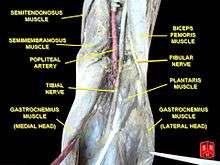Popliteal artery entrapment syndrome

The popliteal artery entrapment syndrome is a rather uncommon pathology, which results in claudication and chronic leg ischemia. The popliteal artery may be compressed behind the knee, due to congenital deformity of the muscles or tendon insertions of the popliteal fossa. This repetitive trauma may result in stenotic artery degeneration, complete artery occlusion or even formation of an aneurysm.
History
The syndrome was first described in 1879 by Anderson Stuart, a medical student, in a 64-year-old male. Hamming and Vink in 1959 first described the management of the popliteal artery syndrome in a 12-year-old patient. The patient was treated with myotomy of the medial head of the gastrocnemius muscle and concomitant endarterectomy of the popliteal artery. They later reported four more cases and claimed that the incidence of this pathology in patients younger than 30 years old with claudication was 40%. Servello was the first to draw attention to diminished distal pulses observed with forced plantar- or dorsiflexion in patients suffering from this syndrome. Bouhoutsos and Daskalakis in 1981 reported 45 cases of this syndrome in a population of 20,000 Greek soldiers. During the recent years the increasing frequency with which popliteal artery entrapment is reported, strongly suggests a greater awareness of the syndrome.
Classification
Love and Whelan proposed a classification of this pathology into four types,[1] according to the various relationships between the popliteal artery and the muscles of the popliteal space. Rich and Hughes described popliteal vein compression, thus adding a fifth type into the former classification. The functional type of the popliteal vessel compression was first described by Rignault et al. in 1985 and labeled by Levien as type VI of the popliteal vessels entrapment syndrome.
Differential diagnosis
Exercise induced lower leg pain includes chronic exertional compartment syndrome,[2] unresolved muscle strain (this classically occurs at the musculotendinous junction of the medial head of gastrocnemius), medial tibia stress syndrome, fibular and tibial stress fractures, fascial defects, nerve entrapment syndrome, vascular claudication (atherosclerotic or popliteal artery entrapment syndrome) and referred pain from lumbar disc herniation.[3]
References
- ↑ Love J, Whelan T (1965). "Popliteal artery entrapment syndrome". Am J Surg. 109 (5): 620–4. doi:10.1016/S0002-9610(65)80016-2. PMID 14281885.
- ↑ Bong MR, Polatsch DB, Jazrawi LM et al. Chronic exertional compartment syndrome: diagnosis and management.Bull Hosp Jt Dis. 2005;62(3-4):77-84.
- ↑ Locke S. Exercise related chronic lower leg pain. Aust Fam Physician 1999; 28:569–573.